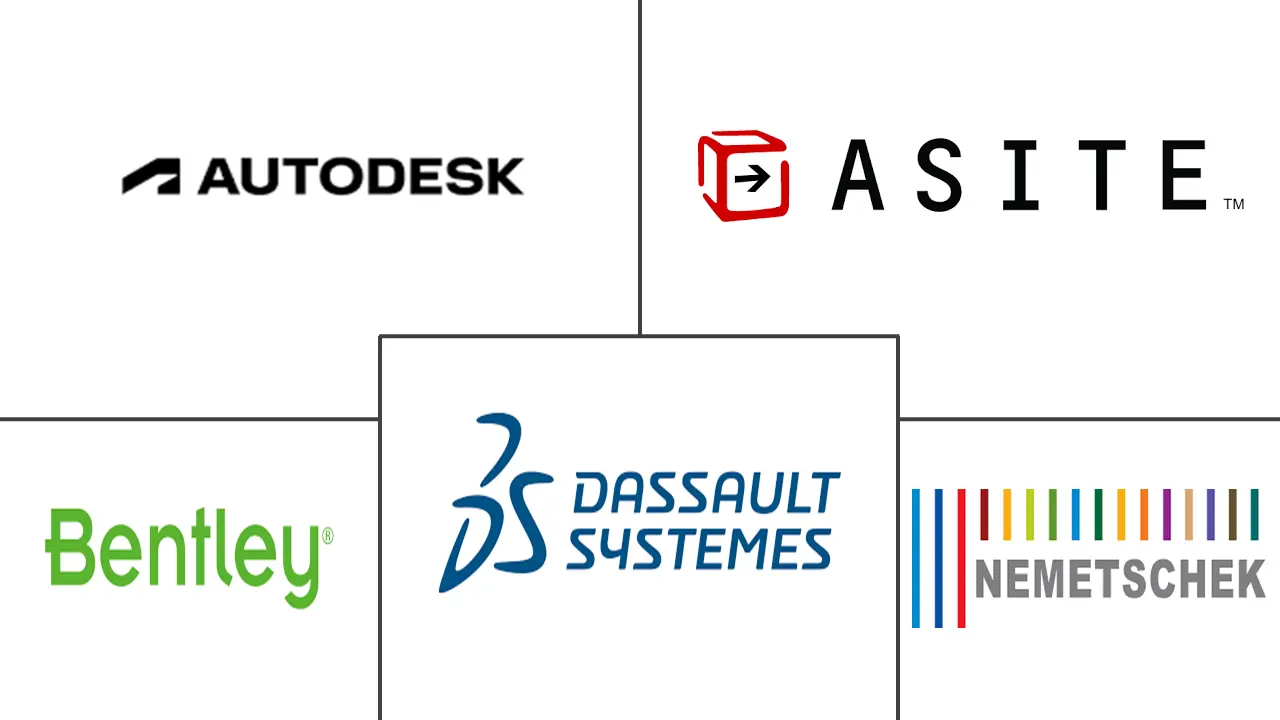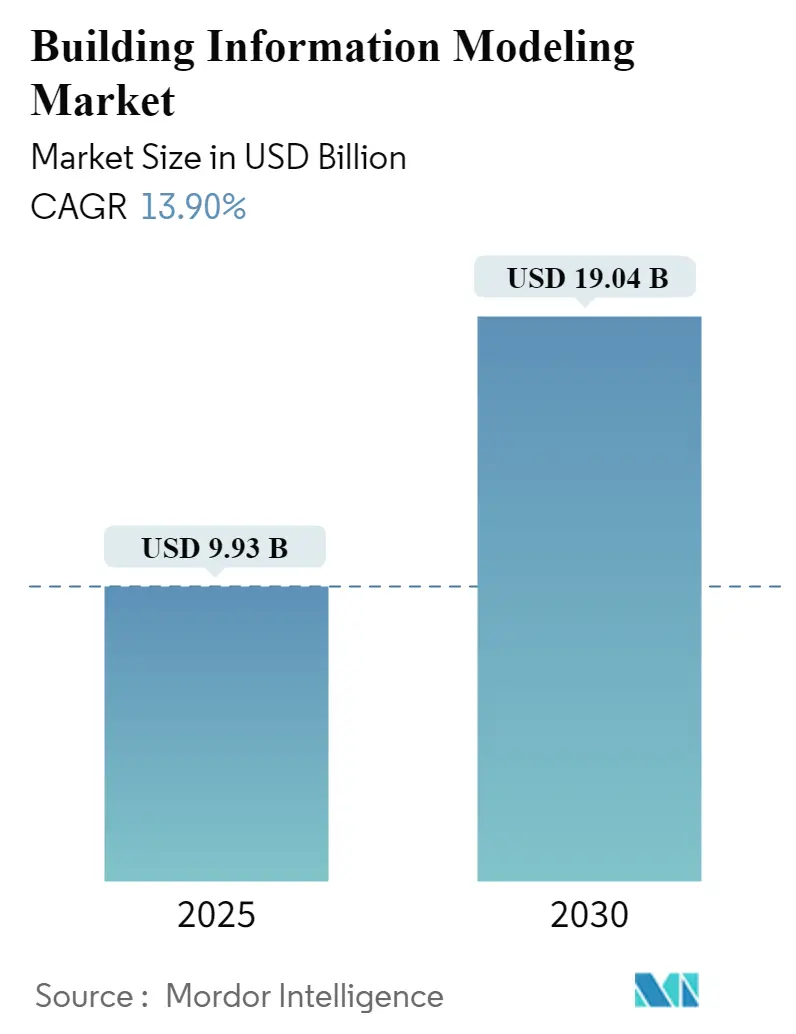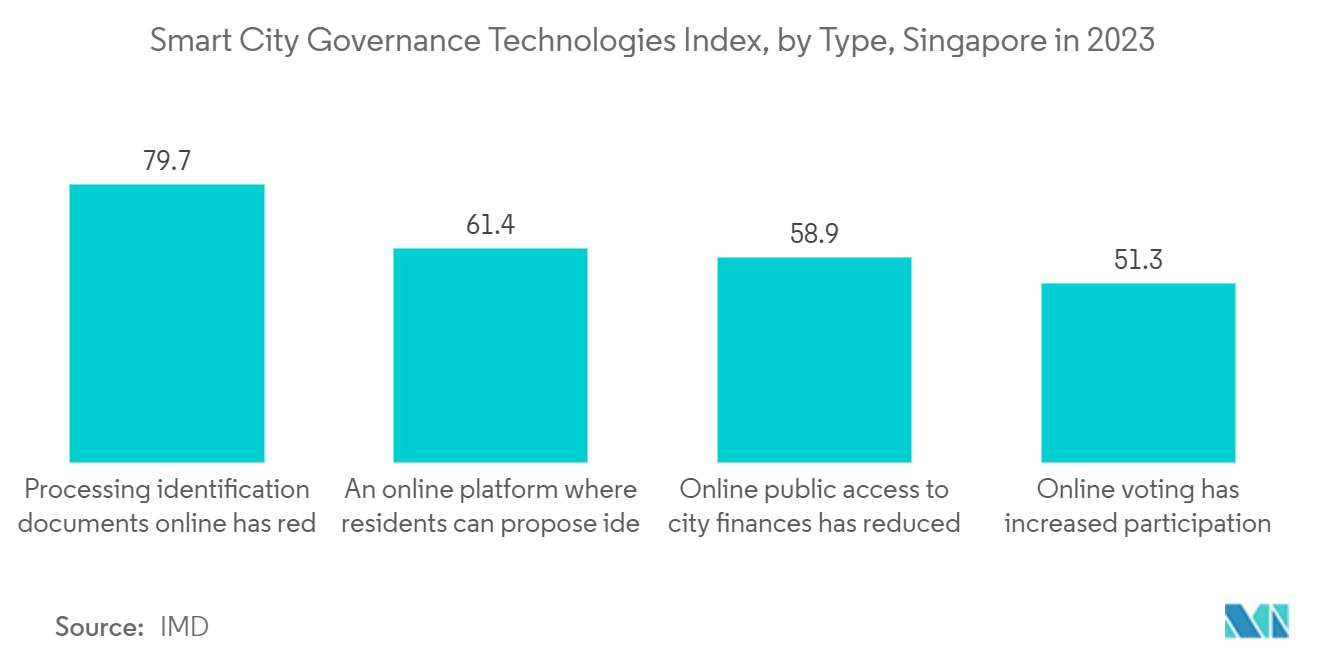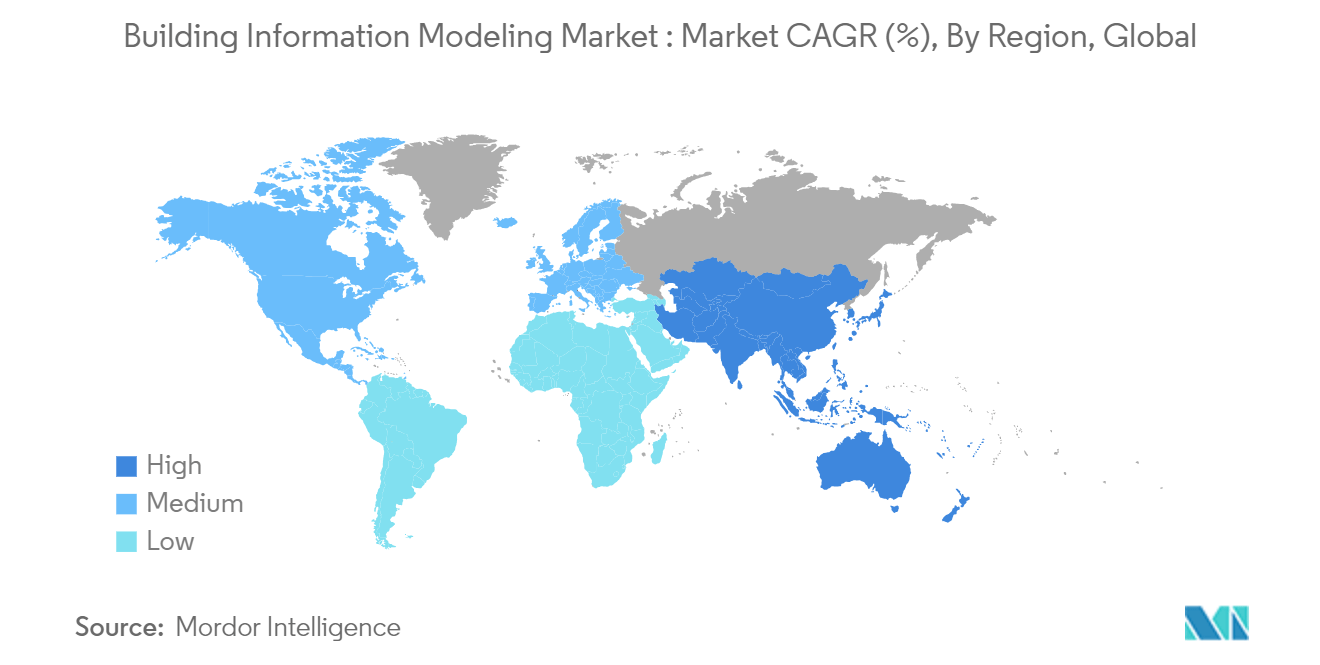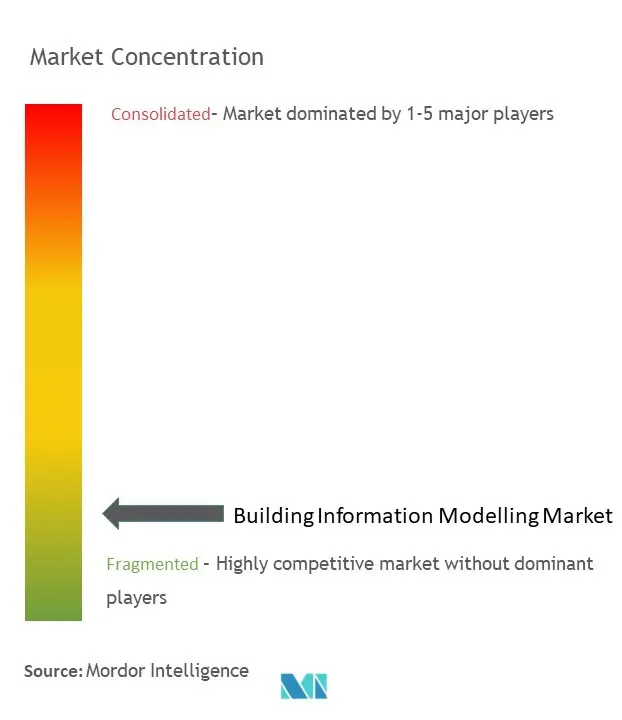Building Information Modeling (BIM) Market Analysis
The Building Information Modeling Market size is estimated at USD 9.93 billion in 2025, and is expected to reach USD 19.04 billion by 2030, at a CAGR of 13.9% during the forecast period (2025-2030).
Building Information Modeling (BIM) is a crucial digital representation process that supports the planning, design, and management of construction projects across various sectors. BIM has significantly reshaped the architecture, engineering, and construction (AEC) industries by enabling enhanced collaboration and improved project outcomes. As the construction industry continues to embrace digital transformation, the adoption of BIM software has seen considerable growth. This adoption aligns with the industry's broader objectives to boost efficiency, reduce costs, and accelerate project timelines. The market landscape for BIM encompasses diverse software and service-based solutions designed for applications ranging from commercial to residential construction.
BIM has grown in relevance as a collaborative tool for contractors, architects, and facilities managers. The integration of advanced technologies, such as cloud computing, AI-driven analytics, and digital twin technology, has further expanded its capabilities. These technologies allow for real-time updates and enhanced oversight of complex infrastructure projects, ensuring precision during construction and enabling better long-term facility management.
The global BIM market is evolving, spurred by a combination of regulatory frameworks and private sector initiatives designed to improve project efficiency. Although BIM has been shown to streamline workflows and increase productivity, challenges such as high software costs and complexity in training have slowed its adoption, particularly among small and medium-sized enterprises (SMEs).
Governmental Mandates and International Standards Encouraging BIM Adoption
- BIM mandates driving adoption in key markets: Government regulations play a pivotal role in the global adoption of BIM technology, especially in regions like Europe and North America. Many countries, including the United Kingdom, Germany, and Singapore, have implemented BIM mandates for public infrastructure projects, underscoring its importance in achieving greater project transparency and efficiency.
- International standards fostering interoperability: BIM standards like ISO 19650, which provides a framework for the management of information using BIM, have been instrumental in ensuring data consistency and reliability. These standards promote smoother data exchanges between project teams, reducing project risks and fostering greater interoperability across various platforms.
- Asia-Pacific's push toward BIM: In the Asia-Pacific region, countries like China and Japan have integrated BIM into national construction policies, especially for large-scale infrastructure projects. Governments in these regions recognize the long-term cost savings derived from BIM’s improved planning and data accuracy, further promoting its adoption.
- Government mandates boost market growth: As sustainability and efficiency in construction gain importance, governmental pushes for BIM adoption are expected to drive further market expansion. These mandates will continue to shape adoption patterns in key markets worldwide, contributing to the global BIM market growth.
Boosting Project Performance and Productivity
- Enhanced project efficiency through BIM: BIM has proven to be invaluable in improving project performance, particularly in large-scale construction projects. The technology enables the creation of highly detailed 3D models, allowing teams to identify potential issues early in the planning stage and coordinate efforts before construction begins. This leads to fewer design errors and costly change orders.
- Shortened project timelines: By simulating various project stages within a virtual model, BIM helps construction teams anticipate bottlenecks, optimize resource allocation, and reduce overall project costs. This simulation capability results in shorter timelines, a critical advantage in an industry where delays can lead to significant cost overruns.
- Increased collaboration and real-time data sharing: One of BIM’s standout features is its ability to enhance collaboration among stakeholders. By providing a shared platform, it ensures that architects, engineers, and contractors can access the same up-to-date project information, reducing communication gaps. Cloud-based BIM solutions, which allow for real-time updates and remote access to project data, further enhance this collaboration.
- Driving productivity in construction: The combined benefits of improved collaboration, accuracy, and project efficiency make BIM technology an indispensable tool for more productive construction management. As project demands grow more complex, the reliance on BIM is expected to increase, ensuring projects are delivered on time and within budget.
Building Information Modeling (BIM) Market Trends
Government Mandates Fueling BIM Growth
- Government mandates fueling BIM growth: The introduction of government regulations requiring BIM usage in public infrastructure projects is a key driver of market expansion. In countries like the UK, regulations mandating BIM Level 2 for public projects have resulted in higher adoption rates. As countries push forward with smart city initiatives, the global BIM market value is expected to grow steadily in the coming years.
- Challenges in BIM implementation: Despite its benefits, BIM adoption is not without challenges. High software costs and the need for comprehensive employee training pose significant barriers, especially for smaller firms in developing regions. Additionally, integrating BIM into legacy systems can be difficult, though advancements in 3D modeling tools and digital twin technology are helping to address these challenges.
- Sustainability initiatives driving demand: The global focus on sustainability is another critical factor propelling the growth of the BIM market. Countries pursuing eco-friendly construction goals, such as Copenhagen’s carbon neutrality target by 2025, are turning to BIM’s data management capabilities to enhance efficiency. BIM is playing a crucial role in the development of smart cities, where its use in managing sustainable infrastructure projects is becoming more prevalent.
North America to Witness Significant Growth
- Technological advancements pushing BIM adoption in the U.S.: North America, particularly the U.S., is at the forefront of BIM market growth, driven by rapid technological advancements and an increased focus on sustainable construction practices. Government investments in infrastructure and private-sector demand are fueling the adoption of BIM, which is becoming essential in projects ranging from architecture to engineering.
- BIM and digital twin technology revolutionizing construction: The integration of BIM with digital twin technology, which creates real-time digital replicas of physical assets, is transforming construction in North America. This innovation is expected to drive U.S. BIM market growth beyond global averages as the country continues to lead in both BIM adoption and technological advancements.
- Leading companies driving innovation: Major players like Autodesk, Bentley Systems, and Trimble are at the helm of BIM innovation in North America. These companies are incorporating cutting-edge technologies such as artificial intelligence and machine learning into BIM platforms to improve design accuracy and reduce project errors.
- Sustainability and smart cities fostering BIM market expansion: North America’s emphasis on sustainability and the development of energy-efficient buildings is contributing to BIM’s market growth. The integration of BIM with geospatial information systems (GIS) and its role in smart city projects are further accelerating the market, positioning the region as a key player in global BIM expansion.
Building Information Modeling (BIM) Industry Overview
Fragmented market with global and niche players: The global BIM market is highly fragmented, featuring a mix of large multinational corporations and smaller niche firms. This diversity fosters competition across various segments, with global leaders like Autodesk and Bentley Systems dominating the market. Meanwhile, smaller players often provide specialized solutions tailored to specific geographic regions or industries.
Global leaders delivering end-to-end solutions: Key players, such as Autodesk, Dassault Systèmes, and Nemetschek SE, offer comprehensive BIM software portfolios. These companies leverage their established industry presence to provide integrated design, simulation, and construction management solutions. Their ability to offer end-to-end services across multiple sectors, including architecture, engineering, and construction, further solidifies their market leadership.
Strategies for success: Diversification and technology integration: For companies to thrive in this competitive landscape, they must focus on diversifying their product offerings and embracing new technologies. The integration of AI, cloud computing, and augmented reality into BIM platforms will be essential in meeting client demands. Ensuring interoperability and seamless data exchange between different software platforms is also crucial for staying competitive.
The Building Information Modeling market is poised for continued growth as industry leaders and emerging players capitalize on technological advancements and increasing demand for efficient, sustainable construction solutions.
Building Information Modeling (BIM) Market Leaders
-
Autodesk Inc.
-
Asite Solutions Ltd.
-
Bentley Systems Inc.
-
Dassault Systems SA
-
Nemetschek SE
- *Disclaimer: Major Players sorted in no particular order
Building Information Modeling (BIM) Market News
- July 2024 - Esri and Autodesk have deepened their partnership to enhance data interoperability between Geographic Information Systems (GIS) and Building Information Modeling (BIM), with ArcGIS Pro now offering direct-read support for BIM and CAD elements from Autodesk's tools. This collaboration aims to integrate GIS and BIM workflows more seamlessly, potentially transforming how architects, engineers, and construction professionals work with geospatial and design data in the AEC industry.
- June 2024 - Hexagon, the Swedish technology giant, has acquired Voyansi, a Cordoba-based company specializing in Building Information Modelling (BIM), to enhance its portfolio of BIM solutions. This acquisition not only strengthens Hexagon's position in the global BIM market but also recognizes the talent in Argentina's tech sector, particularly in Córdoba, where Voyansi has been developing design, architecture, and engineering services for global construction markets for the past 15 years.
- April 2024 - Hyundai Engineering has partnered with Trimble Solution Korea to co-develop a Building Information Modeling (BIM) process management program, aiming to enhance construction site productivity through advanced 3D modeling technology. This collaboration highlights the growing importance of BIM in the construction industry, with the potential to optimize steel structure and precast concrete construction management, shorten project timelines, and reduce costs compared to traditional construction methods.
Building Information Modeling (BIM) Industry Segmentation
Building Information Modeling (BIM) is a 3D model-based process for creating and managing information on a construction project across the project lifecycle. The important outputs of this process are the building Information model, the digital description of every aspect of the built asset to manage the building infrastructure in a better way.
The building information modeling market is segmented by solution type (software, service), application (commercial, residential, industrial), end-user (contractors, architects, facilities managers), and geography (North America (United States, Canada), Europe (Germany, United Kingdom, France, rest of Europe), Asia-Pacific (China, Japan,India, South Korea, rest of Asia-Pacific) and Latin America and Middle East and Africa).The Market Size and Forecasts are Provided in Terms of Value USD for all the Above Segments.
| By Solution Type | Software | ||
| Service | |||
| By Application | Commercial | ||
| Residential | |||
| Industrial | |||
| Other Applications | |||
| By End User | Contractors | ||
| Architects | |||
| Facilities Managers | |||
| Other End Users | |||
| By Geography | North America | United States | |
| Canada | |||
| Europe | Germany | ||
| United Kingdom | |||
| France | |||
| Rest of Europe | |||
| Asia Pacific | China | ||
| Japan | |||
| India | |||
| South Korea | |||
| Rest of Asia Pacific | |||
| Latin America | |||
| Middle East and Africa | |||
Building Information Modeling (BIM) Market Research FAQs
How big is the Building Information Modeling Market?
The Building Information Modeling Market size is expected to reach USD 9.93 billion in 2025 and grow at a CAGR of 13.90% to reach USD 19.04 billion by 2030.
What is the current Building Information Modeling Market size?
In 2025, the Building Information Modeling Market size is expected to reach USD 9.93 billion.
Who are the key players in Building Information Modeling Market?
Autodesk Inc., Asite Solutions Ltd., Bentley Systems Inc., Dassault Systems SA and Nemetschek SE are the major companies operating in the Building Information Modeling Market.
Which is the fastest growing region in Building Information Modeling Market?
Asia Pacific is estimated to grow at the highest CAGR over the forecast period (2025-2030).
Which region has the biggest share in Building Information Modeling Market?
In 2025, the North America accounts for the largest market share in Building Information Modeling Market.
What years does this Building Information Modeling Market cover, and what was the market size in 2024?
In 2024, the Building Information Modeling Market size was estimated at USD 8.55 billion. The report covers the Building Information Modeling Market historical market size for years: 2019, 2020, 2021, 2022, 2023 and 2024. The report also forecasts the Building Information Modeling Market size for years: 2025, 2026, 2027, 2028, 2029 and 2030.
Our Best Selling Reports
BIM Software Industry Report
Building Information Modeling (BIM) Market Research
Our industry analysis on the Building Information Modeling (BIM) market delivers comprehensive insights into current trends, technology advancements, and adoption patterns within the architecture, engineering, and construction (AEC) sectors. The report covers a wide range of BIM applications, including its role in infrastructure projects, sustainability initiatives, and digital twin technology integration. Stakeholders will benefit from in-depth coverage of BIM implementation challenges, such as high software costs and training requirements, alongside strategies to leverage BIM for enhanced project efficiency and collaboration. All these insights are available in an easy-to-read report pdf format, ensuring stakeholders can readily access critical data.
The report also includes a detailed industry forecast, projecting BIM market growth driven by governmental mandates, regulatory standards, and the rising demand for sustainable construction practices. Industry leaders, such as Autodesk and Bentley Systems, are highlighted for their role in driving innovation through cloud-based BIM solutions and AI-driven analytics. This market overview enables stakeholders to anticipate future developments, optimize construction management practices, and align with emerging BIM trends in 2024 and beyond.

